Text photos by: Nivedita Louis
Chettinad, the geographic area limited to a single district in interior Tamil Nadu, has a very rich culture and heritage. Known for its palatial mansions and authentic ‘Chettinad’ food, Chettinad is a one-stop travel destination for foodies and heritage enthusiasts alike, and Devakottai is a bustling town sitting at the heart of Chettinad, near Karaikudi. When historian and novelist Venkatesh Ramakrishnan suggested we take a two-day trip into the heartland of Chettinad, there were no second thoughts for a dozen of us. As the team assembled for the overnight journey at Chennai Egmore station, there was plenty of laughter and fun. Reliving the good old school tour days, we were smiling and prancing around the station like little kids on vacation. As the train hurtled past stations in the cold December night, there were antakshari-s all around, and a card-play marathon ensued late into the night.
The Devakottai Zamin
A word about Venkatesh – he belongs to the Devakottai Zamin family, and what we were about to witness and relish was the priceless Chettinad hospitality at its best. The wake-up call came from him at 4 am! He had gone to Devakottai a couple of days earlier to check on our stay and food. By the time we got down at Devakottai Road railway station, we were fully alert. We reached our homestay, just as the sun was rising. The orange and yellow rays bathed the vintage buildings, birds chirping and people cycling to their daily work. Traditonal Chettinad houses have plenty of rooms built around an open courtyard called ‘Valavu/mutram’.
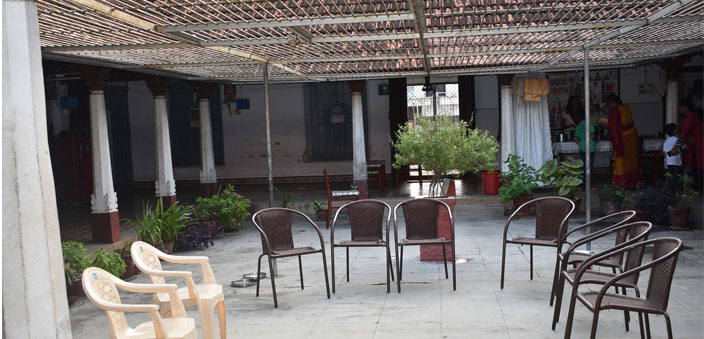
The mutram of Venkatesh’s house was where we had our sumptuous breakfast of vellai appams, fluffy idli-s, sambar, chutney-s, podi and kavuni-arisi pongal – the sweet dish made from red kavuni rice imported from Burma. Burma, Malaya, Singapore and Malaysia – the countries where the Chetti clan had migrated or had business interests. Hard working and enterprising, the Chettiyars of Chettinad have invested their hard earned money in humongous houses here, and this house of Venkatesh was no exception. The Devakottai Zamin had once held the Ramnad Kingdom for ransom! They had established the first Indian owned textile mill in Coimbatore – the Somasundaram Textile Mills Private Limited, and were great patrons of the arts and movies.
After breakfast, we visited the Meenakshi Natesan Kalyana Mandapam in Devakottai. Most of the huge houses of Chettinad have now found new faces as marriage halls. This was no exception. Built with Burmese teak, Belgian glass, traditional athangudi tiles, and now remodeled with part granite flooring, the marriage hall was a beauty. The traditional Chettiyar weddings were large family affairs, held in the main hall and valavu/mutram of the large mansions, with entire extended family attending and sharing the chores.
A Sangam era town
Collecting some snacks, the group headed in a van to Kalaiyarkoil. A town that has existed right from the Sangam era – Thirukaanaper mentioned in Purananooru. Later, the town of Kalaiyarkoil was a fort of the famed Muthuvaduganathar, King of Sivagangai, who was the first to revolt against the British rule in the 1770s, and Maruthu Pandiyar, the brave chieftains who laid down their lives in our freedom struggle. Said to be built in the 7th Century by Maravarman Sundarapandian, and later additions made by King Varaguna Pandiyan and Maruthu brothers, the present nine-tiered Rajagopuram of Sri Swarna Kaleeswarar temple, Kalaiyarkoil, built by Marudhu brothers, towers a lofty 150 feet!
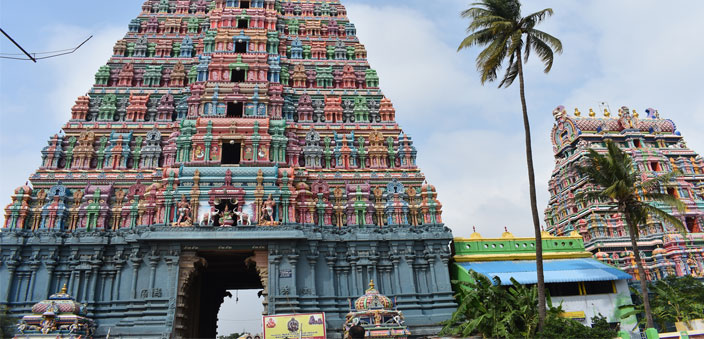
Next to it is another five-tiered older tower built by Sundarapandian. Entering inside, one can find the large four-acre complex housing three separate shrines for Lord Shiva – Swarna Kaaleeswarar, Somaeswarar and Sundareswarar. There is a statue of King Muthuvaduganathar in the temple, his hands folded in prayer. He was killed in the battle of Kalaiyarkoil on June 26, 1772. There are statues of Maruthu brothers. Inscriptions dating to early Pandiyas- Jatavarman, Sundara Pandiyan and Kulasekara I are found in the temple complex. There are separate shrines for Swarnavalli, Soundara Nayagi and Meenakshi.
The temple complex also has a large water tank called ‘aanaimadu’, which is said to have been created by Airavatam, the elephant of Lord Indra. On our way in and out, we had a happy time petting and posing for pictures with the temple elephant Swarnavalli. She was very compliant and happy at the attention she received, munching away the bananas we fed her. The temple which was kept locked for a time was renovated and reopened by the Devakottai Zamin family. It is managed by the King of Sivaganga, ably administered by a trust of Devakottai Zamin family. We next moved on to the Vedanta Mutt, another large mansion belonging to Devakottai Zamin. Vedanta Mutt was set up by A.L.A.R.R.M. Arunachalam Chettiyar, the erstwhile zamindar, who took up sanyas and changed his name to Arunachala Gnana Desikar Swamigal. As we offered prayers to his samadhi inside the mutt, admiring the long pillared corridors and the breezy terrace, we could see the large temple tank and longed to reach the mandapam at the middle of the tank. Orange-stalked pavazhamalli jasmines lay strewn in front of the mutt, lending an ethereal feel.
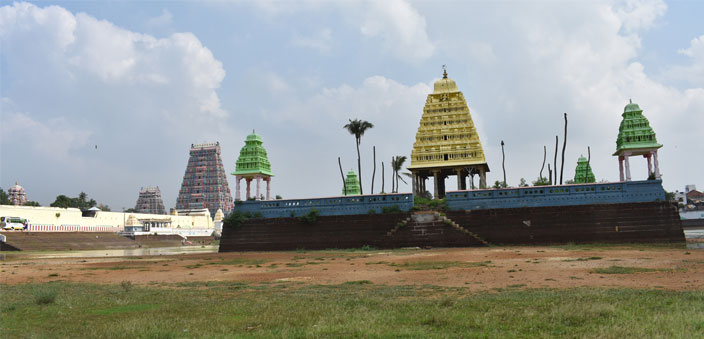
The team walked through the barren tank’s side and reached the middle of the tank and the tall mandapam. The teppakulam where the annual Teppam festival is held in the Tamil month of Vaikasi, bore a serene look. Cooling our heels, we enjoyed the fresh air and clicked pictures. The next spot on our itinerary was Maruthu Pandiyar Manimandapam, a small shrine erected in 2006, on a road opposite to Kalaiyarkoil temple. The Maruthu Pandiyar brothers – Periya Maruthu and Chinna Maruthu, local chieftains of then Sivagangai King Muthuvaduganathar, supported Queen Velu Nachiyar establish her supremacy after the king’s death. They helped Oomadurai, the brother of Panchalankurichi King Kattabomman, escape from the clutches of the British. There started a hunt to kill them, the English forces fanning the entire town knowing they were hiding in their favourite Kalaiyarkoil temple. After a prolonged struggle, they were captured and hanged by the British on October 24, 1801. The deified Periya Maruthu has pooja-s done, and their mother Ponnathal is interred here.

The church at Sarugani
After a sumptuous lunch at the ALAR Trust house at Kalaiyarkoil, we moved on to Sarugani, another small village nearby. The Sacred Hearts of Mary and Jesus Roman Catholic Church is said to be the first church of India dedicated to Sacred Heart. The church’s frontage with interesting stuccos of Sacred Hearts of Mary and Jesus has not been altered, ever since it was built in 1753. Rev. James Thomas De Rossi, the missionary from Italy served in this part of the country from 1736, and was revered by the local population as “Chinna Saveriar”. Consecrated by the Bishop of Cochin, the church has separate altars for Our Mother of Sorrows and St. Theresa. The tomb of Father Leveil, a Jesuit priest from France, called “People’s Priest” who rendered yeomen service in this church, is much revered by the people, and is within the church complex. There is also a separate Grotto, where Father Leveil prayed. On 21st March every year, the Feast of Father Leveil is celebrated in Sarugani when people of different faiths come together. Again, Maruthu brothers are remembered by the faithful here, for it was they who donated land for this church. Chinna Maruthu, just before his execution, requested the British to honour the grants he had given to this Roman Catholic church. The car festival expenses of the church were borne by Chinna Maruthu, and he donated a village called Maraneri to the church.
Pillaiyarpatti and a rare Ganesha
We returned to the Zamin house for lip-smacking evening snacks, and traveled to Pillaiyarpatti. Located near the town of Tirupattur, the Karpaga Vinayagar Temple of Pillaiyarpatti is very ancient, the Lord Tiruveesar and Karpaga Vinayagar both carved out of rock. The rock-cut cave temple is said to have been excavated between 2-4 CE. This temple is revered by the Nagarathar community, as one among their nine Nagarathar clan temples. There are 14 inscriptions in this temple dating from 5CE to 13CE. From 1284 AD, this temple has remained with the Nagarathar. The Vinayagar (Ganesha) of this temple is said to be the oldest Ganesha and also a rare one, a sculpture with two hands.

Interestingly, the sculptor of this Ganesha has affixed his signature in stone, ‘Ekkaatur Kone Paranan Perunthachchan’ in the script of 4-5 CE. Hence the assumption,that this sculpture could have been made in 4-5 CE. The Ganesha is massive – it stands tall at 6 feet, a bas-relief fully covered in silver armour. His trunk is curved to the right, and so he is called Valampuri Vinayagar. There are three shrines for Lord Siva and his consorts in the temple complex – Thiruveesar, Marudheesar and Senchadeswarar, with their respective consorts, Sivagami, Vadamalar Mangai and Soundara Nayagi. The festival of Vinayaga Chathurti is celebrated for ten days with great devotion in the temple.
We attended the mangalaaarti with help from the trustees – the PKNK brothers. Interestingly, the trustees stay back at the temple office for their entire term of about three years, and are selected from the clan in charge of the temple. The brothers took us around their office – a hi-tech kitchen where a massive production of idli-s was underway, and we were taken to the newly constructed gaushala, complete with cool flooring and fans. They opened the stores and showed us the ingredients stocked up for the daily food served at the temple, and also the naivedyam for the presiding deities. The entire area is maintained spic and span, and the temple tank looks serene with clear water.
The temple on a hillock
The next stop was Kundrakkudi Shanmuganathar temple on the outskirts of Karaikudi. The 130-feet high hillock loomed above us, and as it was almost time for closing, we had to jump and hop the steps to reach the temple on top. We were just in time to witness the arthajamapooja, the presiding deity Shanmuganathar with six faces and 12 hands stands majestically, looking as if he is alighting from his peacock. Saint Arunagirinathar has sung his Tirupugazh hymns, the 15th century anthology on Muruga, praising the Lord Shanmuganathar of this shrine. The merciful consorts of Muruga, Valli and Deivanai look graceful, all three seated individually on peacocks. There are some Brahmi epigraphic evidences that point out to the existence of Jain Pallis in this cave temple complex. Here too, there are sculptures of Maruthu brothers. As we were late, we missed visiting the three caves on the western side of the hillock, which are said to be the architectural marvel of the Pandyas, currently under ASI (Archaeological Survey of India) control.
After a hearty meal of parotta-s and curry in a hotel at Karaikkudi, we retired for the night, too tired to even speak with each other. “I shall come and wake you guys at 6 am! Coffee will be served by then, and we have a hectic day ahead”, warned Venkatesh as he left, and we were sleeping like logs in no time.
A walk through Devakottai
The next morning went in a flurry, and by the time we got ready for breakfast, the sun was up and scorching. We were again treated to a hearty breakfast, and dragged our feet to one of the ancestral houses of Venkatesh, watching peacocks loitering around. The house was a mansion with separate armoury. As we got hold of the spears, freshly painted and gleaming, we started a photo-op, jostling to grab them and pose with them. We walked through the town, admiring the Emperor George Gate, erected in commemoration of the coronation of King George V, in 1911, opened by R. NagasundramIyer, Taluq Board President, Devakottai. The next stop was another palatial house of Venkatesh, the Lakshmi Vilas. The rambling mansion with high arches, massive pillars and windows, has once been the abode of the Zamin, and has hosted innumerable VIPs who have visited Devakottai. The external courtyard has a small pond, and in its midst is a podium that has hosted prominent Carnatic music singers, including M.S. Subbulakshmi and M.L. Vasanthakumari. As we entered the house, the chandeliers, the traditional black and white checked tiles and teak banisters, welcomed us to a bygone era of grandeur.
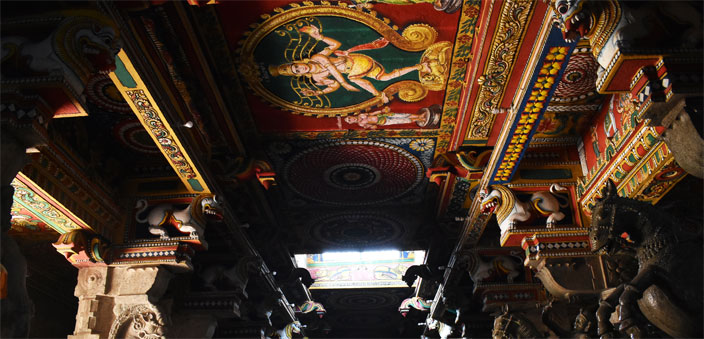
The walls are adorned with amazing Tanjore paintings, adding to the glory. The star attraction was however the underground nilavarai where the riches were once stored. Holding a torch we fumbled down the stairs, standing for a few moments inside the badly lit room with zero ventilation, imagining how the room must have been once, with its gold and silver.
The temple at Vayiravanpatti
Next on the packed itinerary was Vayiravanpatti, Vayiravankoil. Located about 15kms from Karaikudi, this temple is one of the nine Nagarathar temples, and is managed by a trust. The Vairava Theertham, the temple tank, is filled with water, and we were awed by the stucco figures on the five-tiered Rajagopuram. A stucco of Lord Subramaniya with 12 heads and 24 arms peerd down at us from the gopuram. The presiding deity is Valaroli Nathar with his consort Vadivudai Nayagi. However, it is the Bhairavar of this temple who is famous that has fetched the temple and the village the name Vayiravar and Vayiravanpatti. He appears in a separate shrine to the right of Vadivudai Nayagi’s shrine, with his vahan, the dog. Though said to be more than a 1,000 years old, there is a lack of inscriptions to support the claim.
The temple has typical Nagarathar architecture, and can said to have been constructed less than 500 years ago. On the external wall of the sanctum sanctorum, there is a sculpture of Lord Ram praying to Hanuman, with his hands folded. There are interesting sculptures of Chandikeswara, Kannappa Nayanar and Meenakshi Tirukalyanam carved out of a single rock, musical pillars in front of the Dakshinamurthy shrine, a warrior on horseback ready to strike, the Sthala Vriksha, Bikshadana, Manmadha and Rati, Kali, Muruga and many more. The most striking feature of Vairavanpatti temple is, however, the murals on the ceilings. There are 37 murals of Vairava Purana and 43 of Ramayana and Mahabharata, all done with exquisite details and vivid colouring. The mandap looks like a multicolor rainbow, the ceilings and walls shining with paintings. The temple was electrified in 1947.
The next stop is Sathyamurthi Perumal Temple in Tirumayam Fort, near Pudukottai. The temple is said to have been built during 9CE by the Pandyas. The cave temple has Lord Vishnu in a sleeping posture, with Lord Brahma and Devas behind him, as bas reliefs. The Ananthasayanam posture is inside a natural cavern, and the sculptures in the Mukha mandap are exquisite. This is also said to be the biggest reclining Vishnu made of stone, in India. Outside the main shrine are dozens of Nagas, five-headed serpents. The temple complex also houses the Sathyagiriswara Temple, both the temples share the same compound.
The Tirumayam Fort was built on a hill, during the period 1673-1708 by King of Ramnad, Kilavan Sethupathi. Said to have been an extensive one, the fort that we see now is only part of the old fort that existed with seven layers of walls protecting it. Now there are only four. There is a huge canon mounted atop the hill, and six more on the north, south and east gates. There are pigeon holes on the fort walls to enable placing guns for shooting. There is a small cave with a Siva linga found enroute to the hilltop.
The scorching afternoon sun reminded us of our lunch and we scampered to Konapattu, another village to visit an old mansion. After a delicious lunch in the courtyard of Sambandan Chettiar, who had recently turned a century old, we move to our next destination – Athangudi.
The beautiful tiles of Athangudi
Athangudi is a sleepy village in Sivaganga district, known for its handmade Athangudi tiles. The day being Sunday, we couldn’t locate a tile making factory that worked, and chose to visit Lakshmi Vilas or the shooting bungalow first. Awestruck will be an understatement. The grandeur of Italian marble, Burmese teak pillars, exquisite paintings, arches, patterned ceilings in multicolour paint, mirror work on doors, glazed Athangudi tiles and long corridors – the house of N.A.R. Nachiappa Chettiar and A. Muthupatnam has an entry fee of `50, and is worth every single paisa!
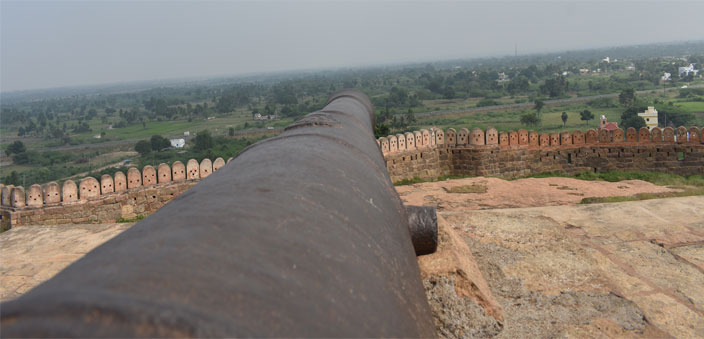
Venkatesh was finally able to get hold of his friend, who promised to show us how Athangudi tiles are made. The traditional tiles are still handmade, and are in great demand. He mixed cement powder and coloured oxide in a liquid slurry state, and poured it into patterned moulds, repeating for different colours, placed on a glass piece. A thin layer of sand is spread over it, and the tile is then filled three-fourth inch with cement, sand and small stones, to get the tile. He explained how the dried tile is then immersed in water for 21 days for curing. Imagine, each one of these tiles goes through this rigorous process, and a lot of careful manual labour is involved. However, when we think of ethnic buildings, the flooring has to be Athangudi tile in these parts. We returned to Devakottai travel-weary and tired. After a short break, we started for the railway station to catch our night train, fully loaded with lovingly packed idli-s and chutney-s. As we continued playing antakshari while waiting for our train back to Chennai, the only wish I had was to stay back and enjoy the small-town peace and life.
Once in a while, I guess, I will be dusting my memories and picking up tiny fragments of happiness that travel brings. As Gustav Flaubert said –“Travel makes one modest. You see what a tiny place you occupy in this world.”

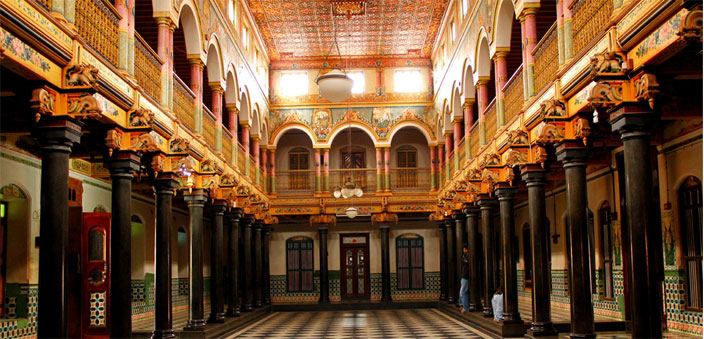
 [/column]
[/column]